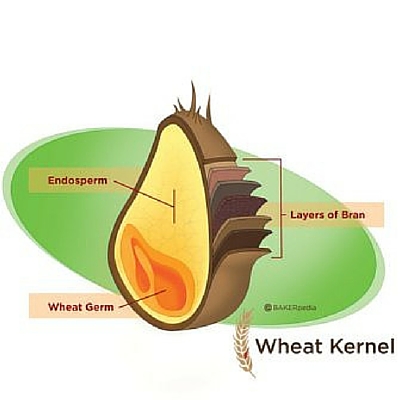Origin
Wheat began as a wild grass, although its exact geographical origin is unknown. Some theories point to ancient Mesopotamia or along the Euphrates and Tigris river as its birthplace. However, most ancient languages include a mention of wheat. The earliest known records of wheat cultivation are by Swiss lake dwellings in 6700 B.C. China began cultivation around 3000 B.C. Early milling practices involved grinding the entire wheat kernel between two large stones.
Wheat has been in the U.S. since colonial times. However, it was during the late 1800s that its cultivation and production took off. Red Wheat varieties were introduced in Kansas by Russian immigrants, and it soon became the staple crop of the American farm land.
Function
The three parts that make up a wheat kernel each have different qualities and nutrients:
Bran
This this outer shell of the wheat kernel and makes up around 14.5 percent of its weight. Milled bran is only used in whole wheat and whole grain flour, or it is sold separately. It consists of trace minerals and a little protein, but primarily insoluble fiber.2
Endosperm
The next layer is the bulk of the kernel, about 83 percent of its total weight. The endosperm is the only part of the kernel used in milling white flour. It has a high portion of protein, along with carbohydrates and iron. The endosperm is also a source of soluble fiber.3
Germ
The germ is the center of the kernel and only 2.5 percent of its weight. This portion is responsible for sprouting the wheat berry. Generally it is removed from flour because its fat content causes rancidity that shortens the shelf life of baked products. However, it is nurtured for sprouted grain flours and mashes. Wheat germ can be sold separately as well.4
Wheat flour
Whole grain flour is made by grinding all three parts the wheat kernel together. Whole wheat flour grinds the bran, germ and endosperm separately, and then mixes them altogether in the end. These two flours naturally include the complete nutritional benefits of the kernel, such as fiber, protein, minerals, and antioxidants. However, whole grain flours characteristically have low water-retention when used in products.
White flour is made from only the endosperm. Enriched wheat flour adds back some of the nutrients lost from the bran and germ, and then some, during an enriching stage. These flours are a good source of iron, B vitamins, and complex carbohydrates, with some having twice the folic acid of whole wheat products.
Sprouted flour or mashes stimulate the germ portion of the kernel to sprout before it is milled into flour. This process increases the kernel’s bioavailability and cracks the outer husk of the bran layer. Sprouted products have some increased digestibility and nutritional value compared to whole grain or enriched grain products.
Production
Modern commercial production of flour replaces stone mills with high-speed steel rollers. Wheat kernels are first cleaned, tempered and then cracked by rollers. Depending on the type of flour, the kernels are then either separated by screens or left together. Next, the pieces are ground with the rollers and sifted through fine screens multiple times until they are fine enough for flour.5
Application
There are six main classes of wheat varieties used for baking. Red and white varieties are the most common, and each is best for specific products. Hard red winter and spring flours are generally used for yeast breads and hard rolls. Soft red winter and soft white flours tend to work better for lighter products such as cakes, pastries, or crackers. Hard white, a relatively newly developed variety, is for yeast breads and noodles. The Durum variety is used for pastas.6
References
- Gegas, V. C., A. Nazari, S. Griffiths, J. Simmonds, L. Fish, S. Orford, L. Sayers, J. H. Doonan, and J. W. Snape. “A Genetic Framework for Grain Size and Shape Variation in Wheat.” The Plant Cell 22.4 (2010): 1046-056.
- Xie, Xueju (Sherry), Steve W. Cui, Wei Li, and Rong Tsao. “Isolation and Characterization of Wheat Bran Starch.” Food Research International41.9 (2008): 882-87.
- Kalinga, Danusha N., Renuka Waduge, Qiang Liu, Rickey Y. Yada, Eric Bertoft, and Koushik Seetharaman. “On the Differences in the Granular Architecture and Starch Structure between Pericarp and Endosperm Wheat Starches.” Starch – Stärke Starch/Stärke 65.9-10 (2013): 791-800.
- Rizzello, Carlo Giuseppe, Luana Nionelli, Rossana Coda, Maria De Angelis, and Marco Gobbetti. “Effect of Sourdough Fermentation on Stabilisation, and Chemical and Nutritional Characteristics of Wheat Germ.” Food Chemistry 119.3 (2010): 1079-089.
- Bramble, Tod, Timothy J. Herrman, Thomas Loughin, and Floyd Dowell. “Single Kernel Protein Variance Structure in Commercial Wheat Fields in Western Kansas.” Crop Science 42.5 (2002): 1488.
- Sęczyk, Łukasz, Michał Świeca, and Urszula Gawlik-Dziki. “Effect of Carob (Ceratonia Siliqua L.) Flour on the Antioxidant Potential, Nutritional Quality, and Sensory Characteristics of Fortified Durum Wheat Pasta.”Food Chemistry 194 (2016): 637-42.

